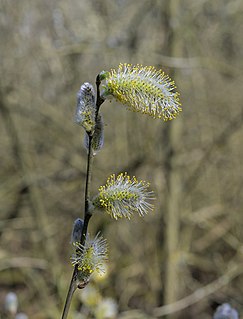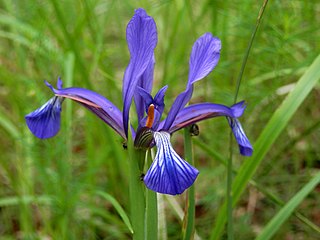
Salix caprea, known as goat willow, pussy willow or great sallow, is a common species of willow native to Europe and western and central Asia.

Pulmonaria (lungwort) is a genus of flowering plants in the family Boraginaceae, native to Europe and western Asia, with one species east to central Asia. According to various estimates there may be between 10 and 18 species found in the wild.

Althaea officinalis, or marsh-mallow, is a perennial species indigenous to Europe, Western Asia, and North Africa, which is used in herbalism and as an ornamental plant. A confection made from the root since ancient Egyptian times evolved into today's marshmallow treat, but most modern marshmallow treats no longer contain any marsh-mallow root.

Filipendula vulgaris, commonly known as dropwort or fern-leaf dropwort, is a perennial herb of the family Rosaceae closely related to meadowsweet. It is found in dry pastures across much of Europe and central and northern Asia mostly on lime.

Saponaria officinalis is a common perennial plant from the family Caryophyllaceae. This plant has many common names, including common soapwort, bouncing-bet, crow soap, wild sweet William, and soapweed. There are about 20 species of soapworts altogether.

Plantago major, the broadleaf plantain, white man's foot, or greater plantain, is a species of flowering plant in the plantain family Plantaginaceae. The plant is native to most of Europe and northern and central Asia, but has widely naturalised elsewhere in the world.

Vinca major, with the common names bigleaf periwinkle, large periwinkle, greater periwinkle and blue periwinkle, is a species of flowering plant in the family Apocynaceae, native to the western Mediterranean. Growing to 25 cm (10 in) tall and spreading indefinitely, it is an evergreen perennial, frequently used in cultivation as groundcover.

Liatris pycnostachya, the prairie blazing star or cattail blazing star, is a perennial plant native to the tallgrass prairies of the central United States.

Ipomoea indica is a species of flowering plant in the family Convolvulaceae, known by several common names, including blue morning glory, oceanblue morning glory, koali awa, and blue dawn flower. It bears heart-shaped or 3-lobed leaves and purple or blue funnel-shaped flowers 6–8 cm (2–3 in) in diameter, from spring to autumn. The flowers produced by the plant are hermaphroditic. This plant has gained the Royal Horticultural Society's Award of Garden Merit.

Verticordia eriocephala, commonly known as lambswool, and common, native or wild cauliflower is a flowering plant in the myrtle family, Myrtaceae and is endemic to the south-west of Western Australia. It is a shrub with one densely branching, spreading main stem, small leaves and dense heads of creamy-white flowers, giving rise to the common names "lambswool" and "cauliflower". It is widespread over its range but becoming less common because of land clearing and illegal collecting of the flowers.

Pachysandra terminalis, the Japanese pachysandra, carpet box or Japanese spurge, is a species of flowering plant in the boxwood family Buxaceae, native to Japan, Korea and China and introduced to eastern North America. It is a slow-growing, spreading evergreen perennial growing to 10 cm (4 in) tall by 60 cm (24 in) broad, with alternate, simple, glossy leaves, and creeping stems. The leaves may yellow in direct sunlight or in winter. When growing in a spreading mass of many plants, a dense cover is formed.

Solanum erianthum is a species of nightshade that is native to southern North America and northern South America. It has been introduced to other parts of the world and has a nearly pantropical distribution. Common names include potatotree, mullein nightshade, velvet nightshade, and salvadora. The potatoes are not the fruits of the trees, they are the leaves.

Anemonoides blanda, syn. Anemone blanda, the Balkan anemone, Grecian windflower, or winter windflower, is a species of flowering plant in the family Ranunculaceae. The species is native to southeastern Europe and the Middle East. The specific epithet blanda means "mild" or "charming". The genus name is derived from the Greek word anemos, or wind.

Vigna marina is a prostrate, creeping vine and a perennial plant. Also known as the beach pea, nanea, and notched cowpea, it is a species of legume in the family Fabaceae.

Hakea leucoptera, commonly known as silver needlewood, needle hakea, pin bush or water tree and as booldoobah in Koori language, is a shrub or small tree with rigid, cylindrical, sharply pointed leaves and white, cream-coloured or yellow flowers in late spring and early summer. It is widespread and common in central parts of the Australian mainland.

Iris sintenisii is a species in the genus Iris, it is also in the subgenus Limniris and in series Spuriae, with tall thin stems, violet-blue flowers and long grass-like leaves. It is a rhizomatous perennial plant, from grass meadows parts of Europe, Russia, and Turkey. It is cultivated as an ornamental plant in temperate regions.

Aristolochia macrophylla, Dutchman's pipe or pipevine, is a vine native to the eastern United States. Aristolochia macrophylla belongs to the plant family Aristolochiaceae and is found primarily along the Cumberland Mountains and Blue Ridge Mountains in the eastern portion of the United States, as well as Ontario, Canada. This species of plant has received considerable attention in the past few decades for the discovery of a potent compound called aristolochic acid, which has been the focus of debate due its harmful side effects.
Iris longiscapa is a plant species in the genus Iris, it is also in the subgenus Iris and in the section Hexapogon. It is a rhizomatous perennial from the deserts of Kazakhstan, Tajikistan, Turkmenistan and Uzbekistan. They have grass-like leaves and lilac-violet or blue-purple flowers on a tall slender stem.

Hormuzakia aggregata is a flowering annual plant in the Borage family, known by the common name massed alkanet.

Ajuga orientalis, also known as Oriental bugle and Eastern bugle, is a herbaceous flowering plant native to the Eastern Mediterranean. It is found in the sandy, dry brushwood and lightly forested regions of the coast. It is usually evergreen, although it may be briefly deciduous in cold winters.



















